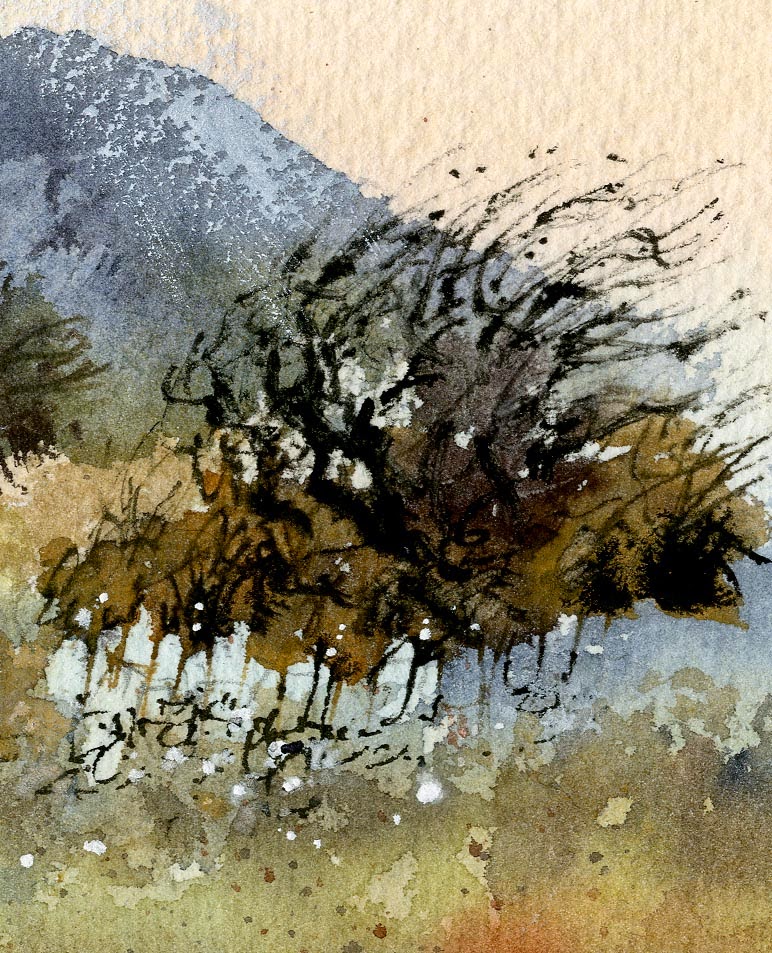Maintaining morale when out sketching on location is vital, and while some might find a whisky flask useful, I generally rely on tea. Sadly last week in Pembrokeshire the cottage where I stayed lacked that vital ingredient, the teapot. Naturally, this was pretty disastrous, so when out and about I made the most of any such facilities. In the sketch below the right-hand building is a superb tea-shop selling the most delicious cakes, and this is why you might detect a certain hastiness in the rendering of the pencil-work.
However hasty we may be in sketching, it pays to consider the composition carefully when creating a painting from the sketch or photograph. Unless the subject is quite a simple affair I normally carry out an intermediate studio sketch to work out where I wish to place the important elements and the main emphasis, together with the sort of atmosphere I wish to convey. In this instance I would move the composition to the right a little so that the left-hand house did not appear in the centre of the composition, as this would be my centre of interest. I would need more detail to be included above the left-hand wall and figures (detail missed because of the urgency of the tea situation), so I would have to resort to memory, a photograph, or the good old imagination. The main figures would be placed further to the right, a little closer to the centre of interest, and I would make full use of the dark runnels of water descending from the centre right – I have already bent them slightly to come towards the viewer as a lead-in. These are the kind of thought processes that go through my mind before I begin the painting.
Don’t underestimate the value of tea for the artist. I’ve even used it on a painting outdoors on occasion. Last autumn while I was running a landscape painting course a lovely German lady was painting a cottage, which filled her paper. When I asked her what was her focal point she replied, “The tea-pot.” Sure enough, there was a teapot in the window. Such observations may not only bring a smile to your viewers, but might also result in a sale.






 If you keep an eye on the weather forecast you might get some idea of what’s to come, but they seem to get it so wrong so often that it pays to be prepared for those glorious days when conditions are just right, whether snow is on the ground or not. If it takes you an hour or more to get your art gear together then you may well have lost the best part of the day, so having all your kit ready for action is vital. As far as keeping warm and dry is concerned, you can see in the photo that I am wrapped up in a warm fleece jacket, a warm sheepskin hat, scarf and thin gloves in which I can sketch quite happily. My trousers are lined, I have woollen socks and boots, thermal vest and inside the rucsack is my waterproof outer gear, a long neck tube which can cover not just my neck but up over my head as well, if need be, a steel thermos flask, mug, etc, so that I can make soup, coffee, tea, cappuccinos, the lot. I’m there to enjoy myself, so why not?
If you keep an eye on the weather forecast you might get some idea of what’s to come, but they seem to get it so wrong so often that it pays to be prepared for those glorious days when conditions are just right, whether snow is on the ground or not. If it takes you an hour or more to get your art gear together then you may well have lost the best part of the day, so having all your kit ready for action is vital. As far as keeping warm and dry is concerned, you can see in the photo that I am wrapped up in a warm fleece jacket, a warm sheepskin hat, scarf and thin gloves in which I can sketch quite happily. My trousers are lined, I have woollen socks and boots, thermal vest and inside the rucsack is my waterproof outer gear, a long neck tube which can cover not just my neck but up over my head as well, if need be, a steel thermos flask, mug, etc, so that I can make soup, coffee, tea, cappuccinos, the lot. I’m there to enjoy myself, so why not?